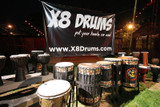Djembe Drum: Wood vs. Synthetic
So you're in the market for a djembe drum but not sure if you should go with a wooden based shell or a synthetic shell.
Well, you've stumbled onto the right site. Shopping for a djembe drum can at times be a bit overwhelming. There are such a wide variety of choices, sizes, and features that sometimes you lose sight of what you want. Hopefully after reading this blog you'll have a better understanding of the distinct differences between wood and synthetic djembe drums so you can make a more informed decision.
MATERIALS
One of the big differences between wood and synthetic djembe drums is the type of material used. Djembe drum shells are typically made of wood or fiberglass.
Fiberglass drum shells are extremely durable and tend to more easily produce drum tones when played. This can make them idea for beginner player whose playing technique is not quite developed - sort of allowing more room to play with tones without completely missing the mark. Many experienced players also report that fiberglass djembes produce a brighter sound and will seek them out when playing in an amplified ensemble where they need to cut through the mix.
Synthetic shell djembes will be less affected by changing weather conditions, which means less tuning time, and may be a better choice for those planning to travel frequently with the drum or for classrooms where the instruments need to withstand a lot of use and mobility.
On the flip side, traditional wooden shells will have a warmer and typically fuller tone than fiberglass shell djembes. Most professional players will prefer the warmth and fuller sound of a wooden shell djembe as their primary drum. Most of our customers choose a wooden shell djembe as their first drum primarily because of the tradition behind them and the hand-carved craftsmanship that goes into each shell.
If you're planning on gigging out a bunch and transporting your djembe around town, keep in mind that wood tends to show scratches more easily, though both are very durable. A drum usually gets most of its scratches when traveling, so be sure to transport your drum in a djembe bag to reduce the chance of damage.
DRUMHEADS
Another difference you need to understand is the type of drumhead used. There are essentially two types of djembe drumheads. The first type is the more traditionally based goatskin drumhead. The tones produced by goatskins vary immensely based on the quality of skin used and whether or not the skin has been treated. Unbleached, thick skins tend to produce deep rich tones. The best way to identify a high quality goatskin drumhead is to look for a stripe down the middle of the drum. The stripe indicates the spine of the back of the goat which is the thickest and strongest skin available. Other skins may be very light or almost completely white. These skins have been treated with a bleaching product to remove all excess goat hair and pigmentations and typically produce more mid-range and higher tones. The lighter skins tend to tune up faster on rope based djembes.
The second type of drumhead is a synthetic head that was created to produce the tones of skin based on heads, however are more durable, in many cases are waterproof, and tend to last longer. In addition, synthetic heads are typically easier to play because they 'crack' a little louder and have a brighter tone when struck. Again, this could be beneficial for a beginner player who is still learning to play.
QUICK REFERENCE:
X8 Drums manufactures both traditional wooden shell djembes with goatskin drum heads and an exclusive line of fiberglass shell djembes with synthetic drumheads. As musicians ourselves, we are dedicated to developing true performance-ready instruments. And whether you choose wood or fiberglass, you can rest assured that sound quality is our number one priority.
Toca Percussion manufactures a PVC shell in their Toca Freestyle Djembe series. PVC is essentially a hard plastic.
All Remo djembes are manufactured using a synthetic shell called 'Acousticon' which is similar to fiberglass. Additionally, all Remo djembe heads are fitted with a synthetic material called 'Fiberskyn'.
Djembe Buying Guide
2. Djembe Wood Source & Lathing [Video]
3. Djembe Shell Carving & Painting [Video]
5. Which Size Djembe is Right for Me? [Video]
6. Key Tuned vs. Rope Tuned Djembe
7. Djembe Drum: Wood vs. Synthetic
8. How to Tune a Djembe [Video]
10. A Note About African Djembes
11. Djembe Rhythm Samples and Exercises [Video]
12. Djembe Rope. Why Quality Matters.
13. Taking Care of your Djembe
15. How to Play the Djembe [Video]
16. Play the Djembe is Easy for All!
Recent Posts
-
Integrating Djun Djun into Modern Music: A Guide for Musicians
What is Djun Djun in modern music? Djun Djun, a type of drum originating from West Africa, is comm …21st Apr 2024 -
Incorporating the Thumb Piano into Modern Music Production
Introduction to the Thumb Piano The thumb piano, also known as the Kalimba or Mbira, is a small …15th Apr 2024 -
The Top 5 Djembes for Beginners: A Buyer's Guide
What is a Djembe? A Djembe is a type of drum originating from West Africa, traditionally made from …13th Apr 2024



